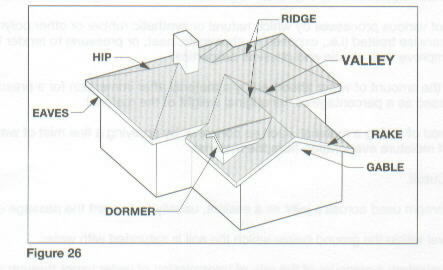Glossary of Roofing and Waterproofing Terms
U-V
A B C D E F G H I JK L M N OP R S T UV W-Z
U-Value: overall thermal conductance. U-value is equal to the inverse of the sum of the R-value in a system (U = 1/R total). Units are Btu/Ft2.Hr.°F.
UBC: Uniform Building Code.
UL: Underwriters Laboratories, Inc.
UL Label: an identification label or seal affixed to a roofing product or package with the authorization of Underwriters Laboratories, Inc. The presence of the label indicates that the product has met certain performance criteria.
Ultimate Elongation: the amount a material stretches during tensile testing before it ruptures. Usually expressed as a percentage of the original length.
Ultraviolet (UV): (1) situated beyond the visible spectrum, just beyond the violet end, having wavelengths shorter than wavelengths of visible light and longer than those of X-rays; (2) relating to, producing, or employing ultraviolet radiation.
Underlayment: an asphalt-saturated felt or other sheet material (may be self-adhering) installed between the roof deck and the roof system, usually used in a steep-slope roof construction. Underlayment is primarily used to separate the roof covering from the roof deck, to shed water, and to provide secondary weather protection for the roof area of the building.
Underwriters Laboratories, Inc. (UL): an organization that tests, rates and classifies roof assemblies for their resistance to: fire, impact, leakage, corrosion of metal components, and wind uplift.
Uplift: see Wind Uplift.
Valley: the internal angle formed by the intersection of two sloping roof planes. (See Figure 26.)
Vapor Migration: the movement of water vapor from a region of high vapor pressure to a region of lower vapor pressure.
Vapor Pressure: the pressure at any given temperature exerted by a vapor that is in equilibrium with its liquid or solid form.
Vapor Retarder: material installed to impede or restrict the passage of water vapor through a roof assembly.
Veneer: (1) a single wythe of masonry for facing purposes, may not be structurally connected; (2) any of the thin layers of wood glued together to form plywood.
Vent: an opening designed to convey air, heat, water vapor or other gas from inside a building or a building component to the atmosphere.
Ventilation Short Circuit: (as it relates to a passive ventilation system where the system is designed for air flow between intake and exhaust vents) a ventilation short circuit occurs when air is introduced into the ventilation system from an area higher than the intake vent thereby minimizing or defeating the effectiveness of the intake vent. One example can be a gable vent in a soffit-to-ridge ventilation system. Air intake from the gable vent can short circuit the stack-effect draw of air through the soffit vents, and interrupt the thorough venting of the roof cavity.
Ventilator: an accessory that is designed to allow for the passage of air.
Verge of Popcorn Texture: the verge of popcorn surface texture is the roughest texture suitable for receiving the protective coating on a sprayed polyurethane foam roof. The surface shows a texture where nodules are larger than valleys, with the valleys relatively cured. This surface is acceptable for receiving a protective coating only because of the relatively cured valleys. However, the surface is considered undesirable because of the additional amount of coating material required to protect the surface properly. The theoretical coverage rate cannot be used without adding a minimum of 50% additional material.
Vermiculite: an aggregate used in lightweight insulating concrete, formed by the heating and consequent expansion of a micaceous material.
Viscosity: the resistance of a material to flow under stress. For bitumen, measured in centipoise. (See Viscous.)
Viscous: resistant to flow under stress. Viscous materials are usually cohesive, and have a sticky consistency.
Void: an open space or break in consistency.
Volatile: descriptive of a substance which passes off easily as a gas or vapor, evaporating quickly.
Volatile Organic Compounds (VOC): organic materials which evaporate at normal temperatures and pressures; organic materials which have vapor pressures greater than 0.1 mm Hg at one atmosphere.
Vulcanization: any of various processes by which natural or synthetic rubber or other polymeric materials may be cured or otherwise treated (i.e., exposed to chemicals, heat, or pressure) to render them non-thermoplastic, and which improve their elastic and physical properties.
